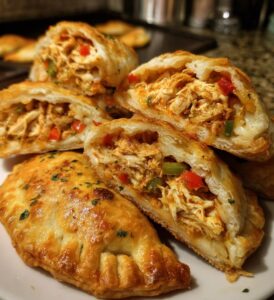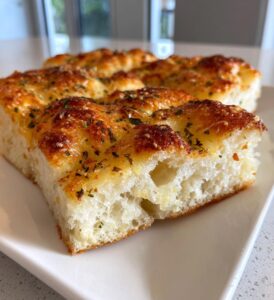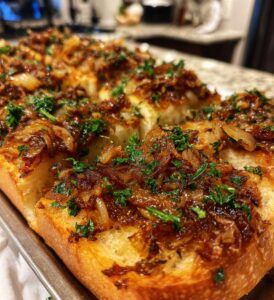Introduction
New Orleans pecan pralines aren’t just sweets—they’re history wrapped in sugar. Rooted in the vibrant French Creole traditions of Louisiana, these melt-in-your-mouth candies have become an iconic Southern treat. With their signature creamy texture, rich pecan flavor, and cultural charm, pralines are more than just dessert—they’re a Southern ritual.
In this complete guide, we’ll explore the fascinating origin of pecan pralines, reveal what makes them unique to New Orleans, and walk you through a foolproof recipe. You’ll learn common mistakes, creative variations, storage hacks, and even where to buy authentic pralines when you’re not in Louisiana. We’ll also tackle frequently asked questions and nutritional tips to help you enjoy these candies guilt-free.
Discover great ideas like this homemade praline recipe and learn how to bring the charm of New Orleans into your kitchen.
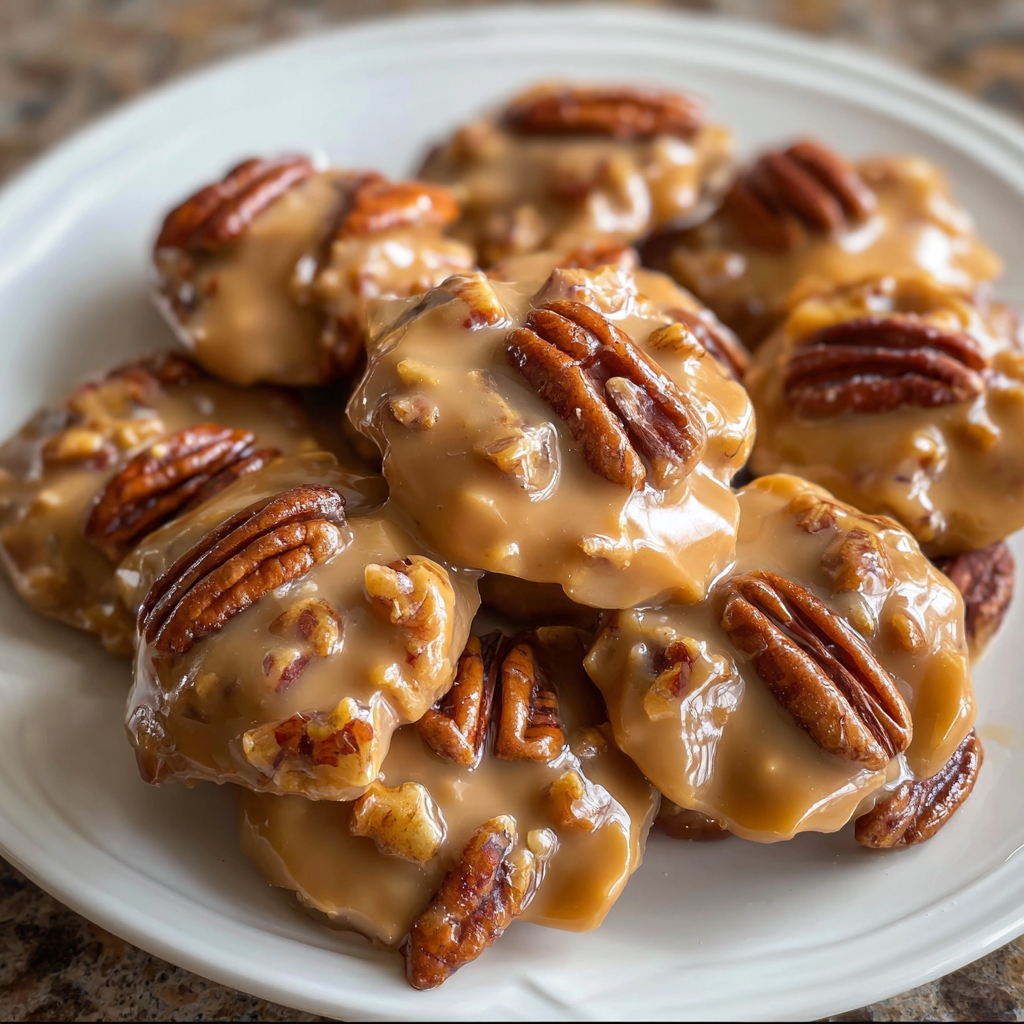
The Rich History Behind New Orleans Pecan Pralines
The French Influence in Louisiana’s Sweet Culture
The story of New Orleans pecan pralines begins in 17th-century France. There, chefs for the diplomat César, Duke of Praslin, coated almonds in caramelized sugar, creating the original “praline.” When French settlers brought this confection to Louisiana, the local twist began.
Louisiana didn’t have almonds—but it had plenty of pecan trees. Enslaved African-American women in New Orleans adapted the recipe, replacing almonds with native pecans and adding local cream. Thus, the New Orleans praline was born—a richer, creamier, melt-in-your-mouth candy unlike the French original.
The recipe was simple but symbolic: sugar, butter, cream, and pecans. This blend of Old World technique and New World ingredients became a staple of Southern hospitality and French Creole cuisine.
How Pralines Evolved in the American South
As New Orleans grew into a cultural and culinary powerhouse, pralines spread through street vendors and general stores. Women—often Black women entrepreneurs—were known as “pralinieres.” They made and sold pralines from scratch, often on street corners in the French Quarter.
Over the centuries, this sweet evolved from a street snack to a gourmet gift. Modern versions include chocolate-dipped pralines, bourbon-infused pralines, and even no-bake pralines. Still, the heart of every praline is the same: buttery, sugary, nutty goodness.
In many Southern households, praline-making is a holiday tradition passed from generation to generation. Whether wrapped in wax paper or boxed as holiday gifts, pralines remain a symbol of Southern warmth and heritage.
Check out No-Bake Pecan Coconut Praline Cookies – A Southern Treat Without the Oven if you’re looking for a twist on tradition.
Print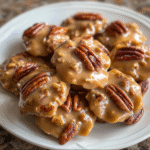
New Orleans Pecan Pralines – The Ultimate Southern Candy Guide
- Total Time: 25 minutes
- Yield: 18 to 24 pralines 1x
Description
Creamy, buttery, melt-in-your-mouth New Orleans pecan pralines, steeped in Creole tradition and Southern charm. A classic candy with rich history and irresistible flavor.
Ingredients
- 1 cup granulated sugar
- 1 cup light brown sugar (packed)
- ½ cup heavy cream
- 4 tablespoons unsalted butter
- 1 teaspoon vanilla extract
- 1½ cups pecan halves (toasted)
Instructions
- Line a baking sheet with parchment or wax paper and set aside. Toast pecans at 350°F for 5–7 minutes until fragrant.
- In a heavy-bottomed saucepan, combine granulated sugar, brown sugar, heavy cream, and butter. Stir continuously until sugars dissolve.
- Attach a candy thermometer and bring the mixture to a boil without stirring. Cook until it reaches 235–240°F (soft-ball stage), about 8–12 minutes.
- Remove from heat, add vanilla extract and toasted pecans. Stir vigorously for 2–3 minutes as mixture thickens.
- Quickly spoon mixture onto prepared baking sheet in round drops.
- Let cool at room temperature for 20–30 minutes until firm to the touch.
Notes
If pralines remain sticky after cooling, they likely didn’t reach the correct temperature. Always use a candy thermometer and avoid making them on humid days.
- Prep Time: 10 minutes
- Cook Time: 15 minutes
- Category: Dessert
- Method: Stovetop
- Cuisine: Southern
Nutrition
- Serving Size: 1 praline
- Calories: 200
- Sugar: 20g
- Sodium: 20mg
- Fat: 11g
- Saturated Fat: 5g
- Unsaturated Fat: 5g
- Trans Fat: 0g
- Carbohydrates: 24g
- Fiber: 1g
- Protein: 1g
- Cholesterol: 15mg
Keywords: pecan pralines, New Orleans, candy, Southern dessert, Creole sweets
What Makes New Orleans Pecan Pralines Unique?
Key Ingredients in Authentic Praline Recipes
At first glance, the ingredients seem deceptively simple. But the magic of New Orleans pecan pralines lies in the quality, ratios, and technique. Traditional pralines use just a handful of ingredients:
| Ingredient | Purpose |
|---|---|
| Granulated Sugar | Primary sweetener, caramelizes |
| Light Brown Sugar | Adds richness and deeper flavor |
| Heavy Cream | Creates the creamy, melt-in-your-mouth texture |
| Butter | Adds smoothness and enhances mouthfeel |
| Vanilla Extract | Introduces depth and aroma |
| Pecans | The nutty core—fresh, roasted preferred |
While other Southern candies may use corn syrup or condensed milk, authentic New Orleans-style pralines rely on heavy cream and butter for their signature creaminess. The pecans are never an afterthought—they’re toasted and folded into the mixture while still warm, ensuring every bite has crunch and warmth.
A soft-ball stage (235–240°F) is critical during cooking. Too hot, and the candy becomes brittle; too low, and it never sets.
Regional Flavor Differences Across the South
Not all pralines are created equal. Across the American South, you’ll find variations depending on the region and even the family:
| Region | Key Differences |
|---|---|
| Louisiana | Creamy, soft, melt-in-mouth texture |
| Texas | Chewier, often thicker and more caramel-like |
| Georgia | Sometimes includes molasses or maple flavor |
| Mississippi | May lean sweeter and thicker |
New Orleans pralines are distinct in their delicate, creamy consistency, almost like a nut-studded fudge. They’re typically flatter than their Texan cousins and always made in small batches for freshness. The deep Creole and French roots also set them apart—these aren’t just candies; they’re cultural legacies.
In fact, many recipes used today are traced directly back to Creole cookbooks and oral traditions that date back over a century.
Don’t miss our Vanilla Pecan Pralines – The Ultimate Guide to Making Southern-Style Perfection for a detailed breakdown of ingredients and preparation methods.
Step-by-Step Guide to Making Classic Pecan Pralines
Essential Equipment and Tools Needed
Making New Orleans pecan pralines isn’t hard, but it does require precision—and the right tools make all the difference. Before you begin, gather everything so you’re not scrambling mid-recipe.
Recommended Equipment Checklist:
| Tool | Purpose |
|---|---|
| Heavy-bottomed saucepan | Ensures even heating, prevents scorching |
| Candy thermometer | Crucial for hitting the soft-ball stage (235–240°F) |
| Wooden spoon or silicone spatula | Stirring without transferring heat |
| Baking sheet lined with parchment or wax paper | For cooling and shaping pralines |
| Ice water bowl | Optional quick test for soft-ball stage |
| Measuring cups/spoons | Accuracy matters here! |
The candy thermometer isn’t optional—it’s essential. Guessing the temperature leads to grainy or runny pralines, both of which ruin the texture.
Traditional Recipe and Cooking Instructions
This recipe yields about 18 to 24 medium pralines, depending on size.
Ingredients:
- 1 cup granulated sugar
- 1 cup light brown sugar (packed)
- ½ cup heavy cream
- 4 tablespoons unsalted butter
- 1 teaspoon vanilla extract
- 1½ cups pecan halves (toasted for best flavor)
Step-by-Step Instructions:
- Prep Work:
Line a baking sheet with parchment or wax paper. Set aside. Toast your pecans in a dry skillet or oven at 350°F for 5–7 minutes until fragrant. - Combine Ingredients:
In a heavy-bottomed saucepan over medium heat, add both sugars, heavy cream, and butter. Stir continuously until the sugar dissolves. - Cook to Temperature:
Attach your candy thermometer to the side of the pot. Without stirring, bring the mixture to a boil and cook until it reaches the soft-ball stage (235–240°F). This will take about 8–12 minutes. - Add Vanilla & Pecans:
Once the right temperature is reached, immediately remove from heat. Stir in vanilla extract and toasted pecans. Stir vigorously for 2–3 minutes as the candy thickens. - Spoon & Cool:
Working quickly, use a spoon to drop praline mixture onto the prepared baking sheet. Each drop should form a round, flattened candy. - Let It Set:
Allow pralines to cool and harden at room temperature (about 20–30 minutes). They should be firm to the touch but still creamy when bitten.
Pro Tip:
If your pralines seem glossy and sticky after 30 minutes, they didn’t set properly—likely due to low cooking temperature or high humidity. Don’t worry—we’ll cover fixes in Part 4.
Looking for inspiration? Try Chewy Homemade Nougat Bars for another rich Southern-style candy adventure.
Troubleshooting Common Praline Mistakes
Why Your Pralines Might Turn Out Grainy or Sticky
Even seasoned cooks can mess up pralines. That’s because these delicate candies demand precision—both in timing and temperature. Let’s break down the most common issues and how to fix them.
Grainy Texture:
If your pralines feel sandy or crystalized, it usually means:
- Undissolved sugar: Stir gently until the sugars melt completely before letting the mixture boil.
- Stirring too much after boiling begins: Once boiling starts, resist the urge to stir.
- Too slow cooling: If you wait too long before spooning onto parchment, sugar may re-crystallize.
Sticky or Runny Texture:
Soft, shiny, sticky pralines that don’t firm up are often the result of:
- Not reaching soft-ball stage (235°F–240°F): Use a candy thermometer. Always.
- High humidity: Moisture in the air can ruin pralines. Try again on a dry day.
- Over-stirring after adding pecans: Stir just until thickened and pour quickly.
Misshaped Pralines:
Are they too flat or too lumpy?
- Too flat: You may have waited too long before spooning them out.
- Too thick or chunky: You might have stirred too long after removing from heat.
How to Fix Texture, Color, and Flavor Issues
Here are practical ways to troubleshoot or salvage your pralines:
| Problem | Quick Fix |
|---|---|
| Too grainy | Reheat with a splash of cream and remix |
| Didn’t harden | Re-cook and bring to proper temperature |
| Burnt taste | Start over—burnt sugar can’t be saved |
| Pale in color | Let cook 1–2 minutes longer for browning |
| Too thick to scoop | Add 1 tbsp warm cream, stir gently |
Pro Tip:
If you’re new to candy-making, test your thermometer by dipping it in boiling water—it should read 212°F. If not, calibrate accordingly.
Creative Twists on the Classic Praline Recipe
Adding Coconut, Chocolate, or Bourbon
Traditional New Orleans pecan pralines are legendary—but why not take things up a notch? Here are flavorful upgrades to impress your taste buds (and guests).
1. Coconut Pecan Pralines
Add ½ cup of shredded sweetened coconut to the mixture just before you stir in the pecans. The coconut gives a chewy texture and a tropical twist.
Pro Tip: Toast the coconut lightly for extra depth.
2. Chocolate-Dipped Pralines
Once your pralines have set, dip them halfway into melted dark or milk chocolate. Let them cool on wax paper.
Flavor Boost: Sprinkle a pinch of sea salt on the chocolate before it sets.
3. Bourbon Pralines
Add 1–2 tablespoons of bourbon after removing the pot from heat and before stirring in pecans. The alcohol will cook off, leaving behind smoky undertones.
This variation is especially popular for holidays and Southern-themed gift boxes.
No-Bake and Vegan Praline Variations
Not into standing over a stovetop? Prefer dairy-free options? You’re covered.
No-Bake Pecan Praline Cookies
Perfect for summer or when you want something quick.
Simple Ingredients:
- 1 cup brown sugar
- ½ cup unsweetened shredded coconut
- 1 cup pecans
- ¼ cup almond or oat milk
- ¼ cup vegan butter
- 1 tsp vanilla
- Pinch of salt
Instructions:
Melt butter, sugar, and milk together. Stir in the rest. Scoop onto parchment and let set.
Discover great ideas like No-Bake Pecan Coconut Praline Cookies – A Southern Treat Without the Oven to try this exact twist.
Vegan Pralines
Swap out dairy butter and cream for coconut cream and plant-based butter.
Flavor Tip: Use maple syrup in place of half the sugar for a deeper taste.
Gluten-Free? You’re in luck. Traditional and modern pralines are naturally gluten-free unless mixed with cookies or crusts.
Best Storage and Preservation Tips
How Long Do New Orleans Pecan Pralines Last?
When stored correctly, pralines stay delicious for up to a week at room temperature, 3 weeks in the fridge, and 2–3 months in the freezer.
| Storage | Lifespan | Tip |
|---|---|---|
| Room Temp | 5–7 days | Airtight container, cool/dry place |
| Fridge | Up to 3 weeks | Keep sealed to avoid moisture |
| Freezer | 2–3 months | Wrap individually and freeze flat |
Avoid stacking unless you separate layers with parchment or wax paper. Humidity will ruin texture—so refrigerate if needed.
Gifting & Freezing Tips
To freeze: Wrap each praline in wax paper, seal in a freezer-safe bag, and label. Thaw at room temp—never microwave.
For gifting:
Package in tins, jars, or festive bags. Add a “Homemade in New Orleans” label for a Southern flair. Great for holidays, weddings, or thank-you gifts.
Where to Buy the Best New Orleans Pecan Pralines
Top Local Shops and Online Sellers
If you can’t make pralines yourself—or just want to taste the best from the source—New Orleans is packed with specialty shops and candy makers that have been perfecting pralines for decades. Here are some top picks known for authenticity and quality:
| Shop Name | Location / Website | What Makes It Special |
|---|---|---|
| Southern Candymakers | French Quarter, New Orleans | Handmade daily, traditional recipe |
| Loretta’s Authentic Pralines | Multiple NOLA locations, ships nationwide | Woman-owned, known for chewy texture |
| Leah’s Pralines | Decatur Street, New Orleans | Small-batch, family-owned since 1940s |
| NewOrleansFamousPralines.com | Online | Ships gift tins and custom packs |
| Aunt Sally’s | In-store & online | Historic recipes with flavor varieties |
Most of these shops offer nationwide shipping, so you can enjoy a taste of the French Quarter from anywhere in the U.S.
How to Spot Quality When Shopping Pralines
Not all pralines are equal. Here’s what to look for when buying online or in-store:
- Ingredients: Look for heavy cream, real butter, and whole pecans. Avoid corn syrup-heavy mixes.
- Texture: New Orleans pralines should be slightly creamy—not brittle like toffee or too chewy.
- Appearance: Slightly glossy but matte as they cool. Flat, round shapes are typical.
- Packaging: Airtight, moisture-proof packaging keeps pralines fresh during transit.
Pro Tip: Avoid “praline-flavored” snacks posing as the real thing. If it doesn’t list cream, sugar, and pecans as the first ingredients, keep scrolling.
Nutritional Profile and Health Considerations
Calories, Sugar Content, and Serving Size
Let’s be honest—New Orleans pecan pralines aren’t diet food. But when enjoyed in moderation, they’re a sweet, satisfying indulgence. Here’s a general nutritional breakdown for one medium-sized praline (about 35g):
| Nutrient | Amount per Serving |
|---|---|
| Calories | 180–220 kcal |
| Total Fat | 10–12g |
| Saturated Fat | 4–6g |
| Carbohydrates | 22–26g |
| Sugars | 18–22g |
| Protein | 1–2g |
Pecans contribute healthy fats, fiber, and antioxidants, but the high sugar content makes pralines a treat, not a staple.
Are There Any Healthier Alternatives?
Yes—and they’re surprisingly tasty. If you want to enjoy pralines without the sugar crash, try one of these tweaks:
1. Low-Sugar Pralines
Use erythritol or monk fruit sweetener in place of sugar. These sugar-free substitutes help reduce calories and prevent blood sugar spikes.
2. Vegan/Dairy-Free Options
Swap out the heavy cream and butter for coconut cream and vegan butter. This not only lowers saturated fat but also works for dairy-sensitive eaters.
3. Portion-Control Bites
Make smaller pralines—half the size—and serve in mini cupcake liners. This makes it easier to enjoy without overindulging.
4. Add Superfoods
Blend in chia seeds or flaxseeds for added fiber and omega-3s. It won’t change the taste much but boosts nutrition.
Don’t miss our Weight Loss Meals section for more guilt-free sweet swaps and healthier dessert ideas.
How New Orleans Pecan Pralines Became a Cultural Icon
Pralines in Mardi Gras and Southern Traditions
New Orleans pecan pralines aren’t just a dessert—they’re a tradition. During Mardi Gras, weddings, and holidays, locals share homemade pralines as symbols of love and hospitality.
Historically, “pralinieres”—Creole women selling pralines on French Quarter streets—helped popularize this sweet across generations. Their legacy lives on in today’s candy culture, where pralines remain a beloved Southern staple.
Pralines and the Spirit of New Orleans
From gift baskets in boutique hotels to treats in tourist shops, pralines are everywhere in New Orleans. They’re one of the most iconic food souvenirs—representing the warmth, history, and homemade flavor of the Crescent City.
For visitors, the praline is often their first taste of New Orleans charm—and one they’ll never forget.
FAQs About New Orleans Pecan Pralines
1. What are New Orleans pecan pralines made of?
Authentic New Orleans pecan pralines are made with sugar, light brown sugar, heavy cream, butter, vanilla extract, and pecans. The creamy texture comes from slow cooking the sugars and cream to the soft-ball stage before stirring in the pecans.
2. What is the difference between pecan pralines and candied pecans?
Candied pecans are whole pecans coated in a crunchy sugar glaze, often baked. Pecan pralines are soft, creamy candies made with pecans suspended in a sugar-cream base. Pralines melt in your mouth; candied pecans crunch.
3. How do you make authentic New Orleans pralines?
Cook granulated and brown sugar with heavy cream and butter until it reaches 235–240°F (soft-ball stage). Remove from heat, stir in vanilla and toasted pecans, then drop spoonfuls onto parchment paper to set.
4. Can you freeze pecan pralines?
Yes! Wrap each praline in wax paper and seal in a freezer-safe bag. Pralines can be frozen for up to 3 months. Thaw at room temperature—do not microwave.
5. How long do New Orleans pralines last?
Stored in an airtight container, pralines last:
- 5–7 days at room temperature
- 3 weeks refrigerated
- Up to 3 months frozen
6. Why did my pralines come out grainy or runny?
Grainy pralines = sugar wasn’t fully dissolved or the mixture cooled too slowly.
Runny pralines = the temperature didn’t reach soft-ball stage or the humidity was too high. Always use a candy thermometer and avoid cooking on humid days.
Check out our Vanilla Pecan Pralines recipe for hands-on tips to avoid these common issues.
Conclusion: The Sweet Soul of New Orleans in Every Bite
New Orleans pecan pralines are more than just sugary treats—they’re a symbol of Southern hospitality, culture, and culinary craftsmanship. Whether you’re making them from scratch, enjoying creative variations, or ordering from a local shop, pralines offer a rich taste of Louisiana’s sweet traditions.
Now that you know how to make them, fix them, store them, and even gift them—there’s no reason not to bring a bit of New Orleans into your kitchen. From the French Quarter to your front porch, these creamy, nutty confections never go out of style.
Looking for inspiration? Try No-Bake Pecan Coconut Praline Cookies or browse our latest dessert recipes.
For daily recipes you can follow me on Facebook and Pinterest.
